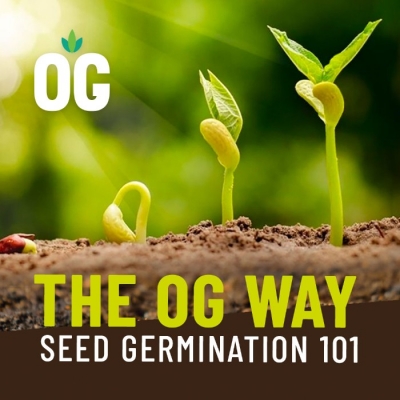IN THIS ARTICLE:
Introduction to Cannabis Reproduction
The Birds and the Bees of Regular Seeds
6 Steps to Grow Regular Marijuana Seeds
Introduction to Cannabis Reproduction
Botanically Perfect Flowers
You’ll be surprised to learn that cannabis, as a plant species, does not produce what botanists refer to as “perfect” flowers. You’re probably thinking, “Well, they look pretty darn good to me”, and we at Overgrow certainly agree. But a perfect flower, in a botanical sense, means that both male and female reproductive elements are housed within the same floral structure, as found in common food crops like apples and beans. A single one of these hermaphroditic flowers could, in theory, pollinate itself, though cross-pollination between plants is sometimes still needed and beneficial in the long term.
Monoecious and Dioecious Plants
A plant without botanically perfect flowers is generally classified as either monoecious or dioecious. Monoecious (Greek for “one house”) plants have male and female flowers on the same plant, but not within the same blossom, as is the case with a hermaphrodite. Interestingly, the term “bisexual” is more apt to describe a plant that produces male flowers (stamen) and female flowers (pistils) at separate sites, according to strict botanical definitions. Corn, cucumbers, and squashes are monoecious plant examples. Dioecious (meaning “two houses”) plants are distinctly either male or female, with the associated flowers or sex organs – examples include asparagus and spinach.
Is Cannabis Monoecious or Dioecious?
If you’re a grower, especially one considering regular seeds, you need to know that your marijuana plants can develop either male or female flowers or both. In other words, cannabis plants can be either dioecious (either male or female) or monoecious, widely called hermaphrodites or “hermies”. However, much like the accepted male, female, and LGBTQ+ gender categories in humans, nowadays, cannabis can have four genders: male, female, true hermaphrodite (M+F sex organs at separate sites), and mixed-gender (“banana” pollen sacs growing in “female” flowers).
What causes Hermaphroditism in Marijuana?
A few factors that can cause hermaphroditic weed plants are bad genetics, nutrient deficiencies, very high temperatures, root rot, light poisoning during dark hours, transplanting, and other stress factors. Be sure to avoid these to increase your chances of growing pure female flowers from photoperiod seeds, regular or feminized.
The Birds and the Bees of Regular Seeds
Just As Nature Intended
Most growers cultivate only feminized genetics for a near-guarantee that all plants will produce treasured female flowers (which can still be stressed into becoming hermies). Did you know that feminized seeds are derived from female plants that have been skilfully tricked into altering their genome in order to germinate into only female marijuana plants? Though this selective breeding modification should not be mistaken for GMO lab engineering.
When we talk about “the birds and the bees” of cannabis, we need to talk about regular seeds. “Regular” in this case means unadulterated (non-feminized) photoperiod (non-autoflowering) genetics, just as nature intended.
Regular seeds have a 50/50 chance of germinating into male or female plants. Males are needed only for their pollen sacs (stamen), which release their contents into the air and pollinate the female flowers (pistils) as part of the natural reproductive cycle necessary for producing more seeds as offspring.
Who Should Grow Regular Seeds?
Regular seeds are therefore essential for breeders seeking to create superior strains or combine specific traits. However, they’re also valuable for experienced growers who either enjoy the challenge of hunting down males or are looking for the perfect phenotype from the genetic lottery, with specific qualities to meet their needs.
If you want to grow regular genetics but don’t want the pesky males to pollinate your coveted female buds to produce seeds, you have to ID the male plants and hermies and carefully discard them – as their pollen can travel for miles. Identifying sex organs during pre-flowering is better suited to cultivators with some experience under their belts.
We don’t recommend regular cannabis seeds for beginner growers, specifically because your first (and sometimes second) grow can be overwhelming. Unless you have an OG to guide you (like we attempt to do), it can be hard to know what to expect. Even then, surprises will likely pop up – all of which are part of the learning curve.
6 Steps to Grow Regular Marijuana Seeds
As we don’t promote regs for complete rookies, let’s focus on the UGPs (that’s “unique growing points”) of regular seeds.
Step 1: Germinate Your Seeds
We recommend, nay, we insist on following our Seed Germination 101 article to maximize your success rate. It provides standard seed-popping practice in simple, practical terms.
Step 2: Veg As Usual
A bit of basic marijuana growing hygiene, as per usual, is all that’s necessary during the vegetative stage. Basic feeding, watering, pruning, and disease prevention – standard for anyone with a couple of grows under their belt.
Step 3: Know Your Environment
Remember, regular marijuana seeds have a roughly 50/50 chance of germinating into males or females – they’re generally “dioecious”. It’s impossible to tell which are which until their M/F flowers (reproductive organs) start to show. Indoors, it’s a little easier as you know to expect them within 1-3 weeks after flipping to a 12/12 light/dark light cycle. Outdoors can be a bit trickier, especially if you don’t have prior experience (in general or in a new climate) or are unsure exactly what you’re looking for. So, it’s essential to have a keen eye and be able to ID a plant’s sex organs.
Step 4: Identify Each Plant’s Gender
The most fundamental reason to ID your plants’ genders is to separate males from females to prevent the lads from pollinating the ladies. Cross-pollination will result in your ladies producing seedy buds as part of the natural reproductive cycle of cannabis. The precious female flowers we all know and love are called “sinsemilla,” meaning “without seed.”

As each plant matures, when the environment is just right (reduced outdoor daylight hours or flipping the light cycle to 12/12 indoors), your beautiful marijuana babies will flip a genetic switch and start “pre-flowering”. It’s at this stage that males will begin to develop pollen sacs (appropriate, from a human perspective), also called “stamen”, and females will develop “pistils” (hairs, a bit less ladylike).
Male preflowers (stamen) usually appear first in the shape of little balls or “bananas”, later going on to form bell-shaped clusters (male flowers). Female preflowers (pistils) appear like a pair of white hairs in a V shape (stigma) emerging from a green calyx, which later cluster together to form buds (female flowers). While rare, some plants can develop into mixed-gender plants where male bananas appear in female flowers. Less commonly, they can become true hermaphrodites (M+F sex organs at separate plant sites). These “hermies” display both genders’ sex organs, often due to unstable genetics or as a survival mechanism in response to stress like high temps or light poisoning.
Keep your eyes peeled as early as three weeks post-germination. Look out for these preflowers at the nodes (right where the branches meet the stems), often in the upper reaches nearest to the light source (see the above image for a visual). You’ll want to remove both herms and males, leaving the ladies to do their thing and deliver only clean, coveted, smokable flowers.
Step 5: Separate Males From Females
Listen up. You must be vigilant in your male and female separation and culling (or isolation for breeding). A single male can pollinate your entire batch of females, even from a distance of kilometres away (pollen spreads through the air).
Hunt the males down, weed them out, and carefully isolate (for breeding) or dispose of them entirely because all it takes is a little bit of pollen sneaking through to ruin your whole harvest.
This way, you’ll be left with only ladies to produce marijuana buds high in THC, other cannabinoids like CBD, as well as terpenes and other beneficial compounds.
Step 6: Breeding
“I’m a breeder, and I didn’t know it”. This might sound like something to be proud of – maybe you get lucky and even produce some respectable genetics. But we’ve got news for you – stable breeding is a meticulous process and very hard work! It takes a considerable investment of time, knowledge, and trial and error over many years to know what you’re doing.
Cheap, unstable “bag seeds” are nothing but trouble. Fortunately for you, we stock cannabis seeds from the world’s best breeders, who’ve spent several years to decades of their time identifying, experimenting, and stabilizing the most elite genetics from around the globe. Let’s leave breeding to the pros and simply enjoy our grows.
Visit our breeders page or jump straight to our regular seeds catalogue to find the strain that most tickles your fancy. You won’t regret it.




